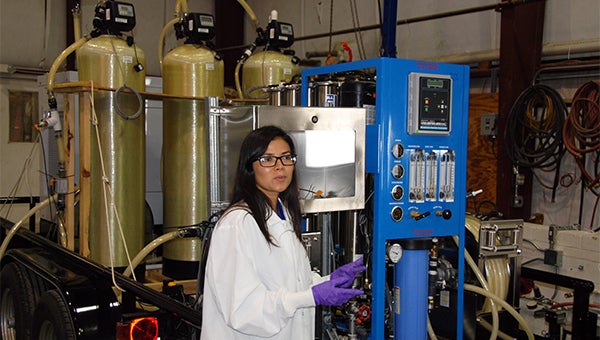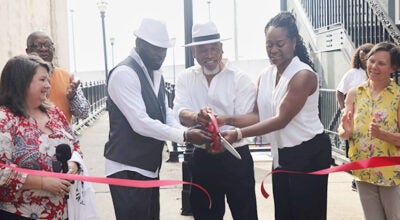A childhood illness started Martinez-Guerra on a path that ended in a lab at ERDC
Published 10:00 pm Sunday, September 17, 2017

- WATER PURIFICATION: Edith Martinez-Guerra helped to design the DETS system at ERDC, which is a water purification system designed to be used after a chemical spill or attack and can remove chemical, biological, radiological or nuclear contaminants from water. (Rob DeDeaux • ERDC Public Affairs Office)
Water has flowed through Edith Martinez-Guerra’s life, carrying her in its current from a one-room house in El Salvador with dirt floors she shared with seven relatives to a career as an environmental engineer at the U.S. Army Engineer Research and Development Center in Vicksburg.
From the contaminated water she and her family were forced to carry a mile a day and which eventually gave her Hepatitis A, to the rivers her parents were forced to cross as they illegally immigrated to the United States in search of a better life and finally to the water purification systems she helps design at ERDC, Martinez-Guerra’s has been defined by water.
Martinez-Guerra was born in a small village in El Salvador named El Nin͂o in the shadow of the volcano Chaparrastique. The streets in the town were made through the years as rain water running off the side of the volcano cut trails through the landscape.
No running water, even to this day, and sparse electricity created a different world in El Nin͂o than the one in San Miguel, only 20 miles away.
“When you are a kid, I don’t think you pay much attention,” Martinez-Guerra said. “You can see the difference when you go to the city, which is like 20 minutes away. You can see the huge difference. You don’t have to go that far to see, but when you are a kid, I guess you don’t worry much.”
Martinez-Guerra was the product of young love between her 13-year-old mom and 17-year-old dad, whose relationship would ebb and flow over the years until they reconnected years later in America and were eventually married.
One week after she was born, in Jan. 1989, Martinez-Guerra’s father left El Salvador and illegally immigrated to the United States.
“He was a teenager, came to California and forgot about having a daughter,” she said. “My mother was living with his family at that time, but he kind of cut all connections with her too so she had to go back to her parents.”
Martinez-Guerra lived with her grandparents for most of her adolescence as her mother found a job as a maid in San Miguel and was forced to stay there most nights.
“She didn’t go to school,” she said. “They kind of treat you like a grown-up there when you are 13. She left to go to the city to work, but she had to stay over. She was a maid so she had to stay overnight and she would come see me once a month.”
Whereas circumstances kept her mother from attending school, Martinez-Guerra was determined from a young age to receive an education.
“My grandmother kind of didn’t think education was for women,” Martinez-Guerra said. “She never sent any of her daughters to school. My mother never went to school or her sisters except the young one, because she is my age and they felt they had to send her because I would not stop asking to go to school.”
Martinez-Guerra was taught to read, write and do basic math at a young age by her paternal aunt, who had received an education. At the age of seven, she finally convinced her grandmother to allow her to attend school. Her fight for an education didn’t end there though. She constantly had to battle for the right to be educated.
“It was very difficult for me every year because I have an older aunt and she hated me going to school because she didn’t have the chance,” she said. “They would make me do lots of things to go to school. We had to get up early to clean. If not, we couldn’t go to school.”
El Nin͂o is a town of farmers. Cows, sugar cane, corn and even beans grown high up on the volcano provided the livelihood of those who live there. Groceries had to be bought in San Miguel and from a young age it was her job to make the trip for her grandmother.
“Since I was a kid, I was my grandmother’s pet,” Martinez-Guerra said. “If she wanted me to go to the city to do groceries, I was about eight and I would go by myself. Just get a bus and go. Because of the bus stops, it would take about an hour. If there wasn’t a bus, we would have to walk an hour to the buses that were going somewhere else.”
With no running water or electricity, Martinez-Guerra, her family and all those who lived there were forced to walk a mile a day to collect water.
“There was a well and we had to buy it from them,” Martinez-Guerra said. “It was like a mile we had to walk and bring it over our heads. It was like three gallons
“Since I remember (we had to help carry water). Since you are a kid, you do it even if you can just get a pitcher of water. As you grow, the volume of you bucket grows.”
The water was all they had, but it was far from clean. Last year, Martinez-Guerra returned to El Nin͂o and tested the water finding “lead, pathogens and some other things.”
Martinez-Guerra eventually contracted Hepatitis A from the water and she said other children “they look pregnant, but they have a lot of worms in their stomach.”
“I was six or seven. I don’t remember my exact age. I got sick from drinking that contaminated water,” she said. “I got Hepatitis A. They say it does irreversible damage to your liver. I can’t donate blood. I don’t remember what they did. I just remember my neighbor took me to the hospital. I remember being in a hammock sick.”
The impact of her illness has resonated through her life and created a youthful desire to work to purify water that would eventually grow into a career. That desire and her unquenchable need to be educated have shaped her life and led her along the path eventually leading to a lab at ERDC.
Martinez-Guerra first heard the word engineering in second grade from her teacher Atilio, who she says was like her father and everyone’s favorite teacher. She didn’t know it’s meaning at the time, but the word and the idea stuck with her.
“He told me I was going to be a civil engineer, I am one because of him,” she said. “I didn’t know what it meant, but he said they build bridges. So I said I want to build bridges.
“Then when I figured out what Hepatitis A was, I was like civil engineers clean water, but at that time environmental engineering didn’t exist. I wanted to clean water.”
Her mother left El Salvador when Martinez-Guerra was seven and made the journey through Guatemala, Mexico and eventually illegally across the border into America.
“Sometimes we make the joke that they call Salvadorians ‘three time wetback’ because we have to cross the border to Guatemala and then Mexico and then here,” Martinez-Guerra said. “A lot of people go with just whatever they have on.”
Her mother was forced to save thousands of dollars with help from her brother, who was in America, and then put blind faith in a guide that she would reach California safely.
Martinez-Guerra’s father had received a green card by that time with the help from his father, who was in America legally.
Her mother reconnected with him and eventually obtained a green card once they were married.
That opened the door for them to bring Martinez-Guerra to America with a green card in 2004 when she was 15.
The family lived in California at the time, but moved to Nashville, Ark. soon after Martinez-Guerra arrived in America.
Speaking little English, Martinez-Guerra enrolled as a sophomore in high school and learned the language with help from the Spanish teacher, country music and classmates.
“I didn’t want to come to America,” she said. “I wanted to be the best student in the country (El Salvador), but my parents were here and I knew that would be best for me if I wanted to be educated. In my country, it doesn’t matter how good you are if you don’t know the right people.”
From the time she started school, Martinez-Guerra wanted to “wanted to make it in school until the end.”
She received her bachelors in civil engineering from Arkansas State and her masters and Ph.D. in civil/environmental engineering from Mississippi State.
It was at MSU where she first heard of ERDC and the wastewater team and saw the potential of fulfilling her dream of working with water.
She has been employed as a Research Environmental Engineer at ERDC for a year now and has worked with the wastewater team to design the DETS system, which is a four step process including two filters, a water softener and a reverse osmosis system, which removes more than 99 percent of all contaminants caused by chemical spills or attacks.
“It is in case of a chemical attack or spill,” Martinez-Guerra said. “The system cleans chemical, biological, radiological or nuclear so it can be used for a variety of things. Mainly it is used for warfare.”
She may not be working with drinking water, but she hopes the skills she is learning at ERDC will enable her to one day make an impact in her hometown in El Salvador and others like it where those living there have no choice but to drink the contaminated water that is all they have.
“I feel like all kids deserve to have clean water. It is basic. I want to learn more skills and then later on apply them. I feel like right now I am an apprentice,” she said. “I feel like one day I can make a difference in water. You see kids dying because they don’t have water, when we have so much water.
“It is sad. I didn’t even know if I should tell me family what was in it and worry them or let them keep drinking it. I told them and my aunt was worried about it and my grandmother said her ancestors have been drinking it and they lived long.
“The problem is that the area is remote for the piping systems. I don’t think we will ever complete that because our government is never helpful. They don’t care about those areas.”





